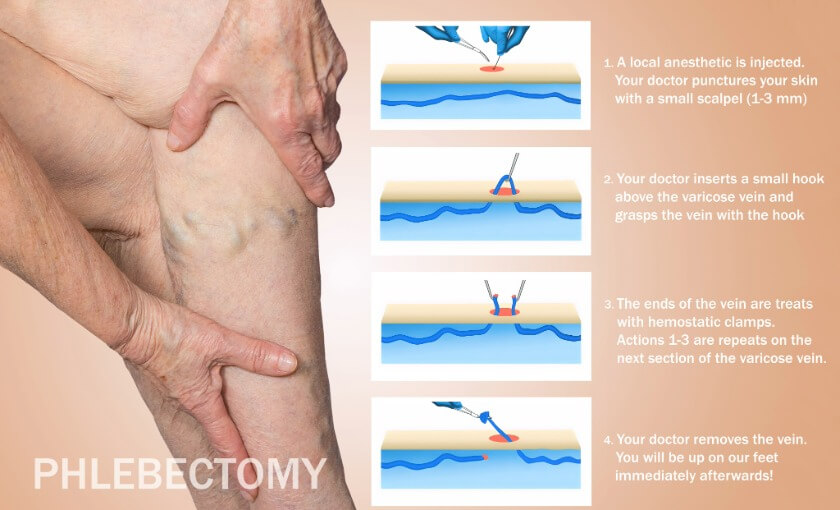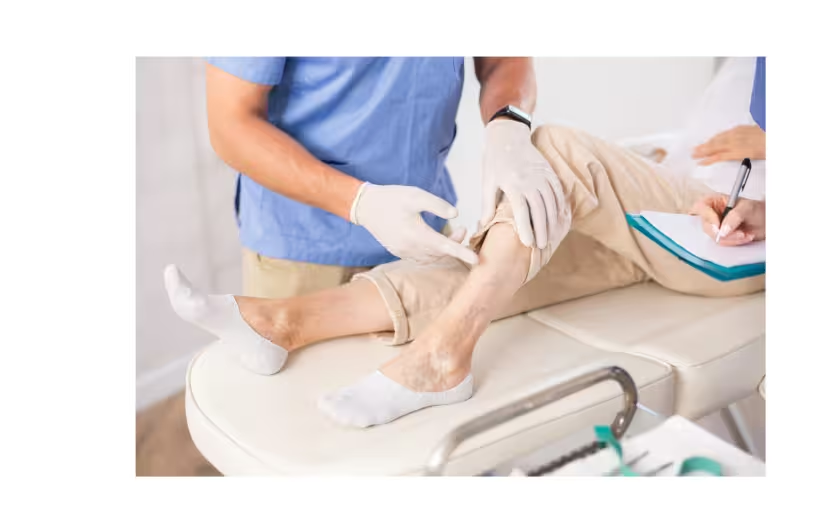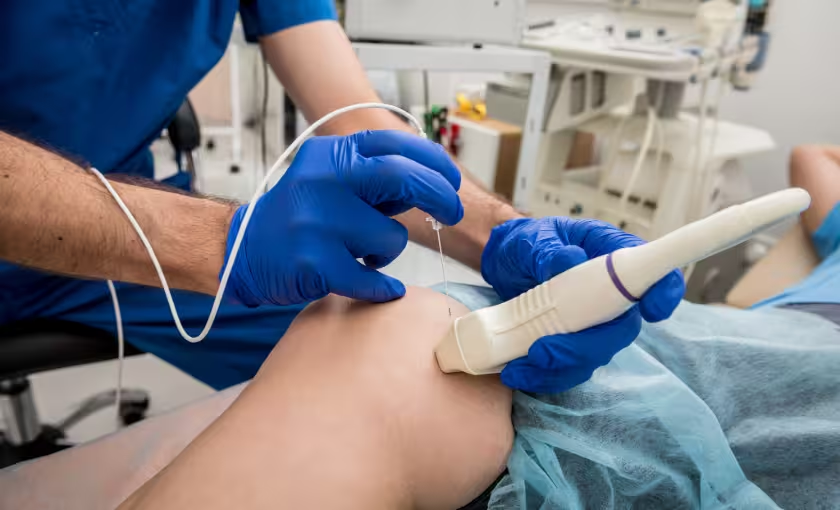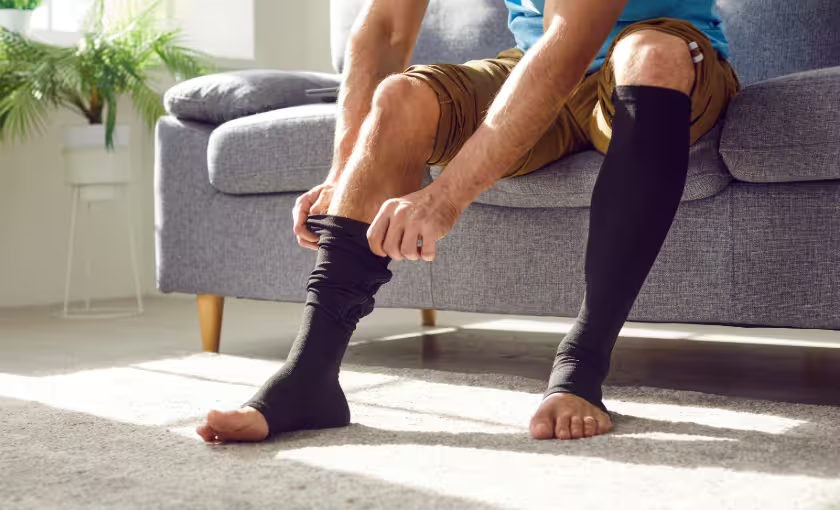Ambulatory Phlebectomy: Surgical Excellence for Large Varicose Veins

Ambulatory phlebectomy represents the pinnacle of surgical technique in venous medicine, offering patients a minimally invasive surgical solution for large, bulging varicose veins that may not be suitable for catheter-based treatments. This sophisticated procedure combines the precision of microsurgical techniques with the effectiveness of traditional surgical approaches, providing patients with immediate, dramatic improvement in both the appearance and symptoms of problematic varicose veins while maintaining the highest standards of cosmetic outcomes.
BASS Vein Center's mastery of ambulatory phlebectomy techniques has been refined through decades of surgical experience and thousands of successful procedures. The center's commitment to surgical excellence, combined with ongoing training in the latest microsurgical techniques and instrumentation, ensures that patients receive the most advanced surgical care available for their varicose vein problems. This expertise in ambulatory phlebectomy makes the center a preferred destination for patients with complex vein problems that require surgical intervention.
Understanding ambulatory phlebectomy involves appreciating both the surgical skill required to perform the procedure and the artistry involved in achieving optimal cosmetic outcomes. While the concept of surgically removing problematic veins is straightforward, the microsurgical techniques used in modern ambulatory phlebectomy require extensive training and experience to master, making the difference between good and exceptional surgical outcomes.
The Evolution and Refinement of Ambulatory Phlebectomy
Ambulatory phlebectomy has evolved significantly from its origins in traditional vein stripping surgery, incorporating advances in microsurgical techniques, specialized instrumentation, and refined surgical approaches that have transformed it into a minimally invasive procedure with excellent outcomes and minimal scarring. This evolution represents decades of surgical innovation and refinement that have made ambulatory phlebectomy the preferred surgical approach for appropriate candidates.
The development of specialized microsurgical instruments has been crucial to the advancement of ambulatory phlebectomy techniques. These instruments, including micro-hooks, specialized forceps, and illuminated retractors, allow surgeons to remove problematic veins through incisions that are often less than 2-3 millimeters in length, dramatically reducing scarring and improving cosmetic outcomes compared to traditional surgical approaches.
Surgical technique refinements have focused on minimizing tissue trauma while maximizing the completeness of vein removal. Modern ambulatory phlebectomy techniques utilize careful tissue handling, precise incision placement, and meticulous attention to hemostasis to achieve optimal outcomes with minimal post-operative discomfort and rapid healing.
The integration of ambulatory phlebectomy with other vein treatment modalities has created comprehensive treatment approaches that can address all aspects of complex venous disease in a coordinated manner. This integration allows surgeons to combine ambulatory phlebectomy with procedures like radiofrequency ablation or sclerotherapy to provide complete treatment for patients with multiple types of vein problems.
Patient selection criteria have been refined through extensive clinical experience to identify the candidates who will benefit most from ambulatory phlebectomy while minimizing the risk of complications. These criteria consider factors such as vein size, location, patient anatomy, and overall health status to ensure optimal outcomes.
Indications and Patient Selection for Ambulatory Phlebectomy
Ambulatory phlebectomy is specifically indicated for certain types of varicose veins and patient situations where other treatment modalities may not be as effective or appropriate. Understanding these indications and selection criteria is essential for achieving optimal outcomes and patient satisfaction.
Large, bulging varicose veins that are too large or tortuous for effective catheter-based treatment represent the primary indication for ambulatory phlebectomy. These veins, which often protrude significantly from the skin surface, can be completely removed through tiny incisions, providing immediate and dramatic improvement in both appearance and symptoms.
Superficial varicose veins that are close to the skin surface are ideal candidates for ambulatory phlebectomy, as they can be easily accessed and removed through small incisions without significant tissue dissection. The proximity of these veins to the skin surface makes them particularly suitable for the microsurgical techniques used in ambulatory phlebectomy.
Recurrent varicose veins following previous treatment may be effectively addressed with ambulatory phlebectomy, particularly when other treatment modalities have been unsuccessful or are not appropriate for the specific anatomical situation. The surgical approach allows for the complete removal of problematic veins that may not respond to non-surgical treatments.
Cosmetic concerns related to prominent varicose veins that significantly impact patient confidence and quality of life represent an important indication for ambulatory phlebectomy. The excellent cosmetic outcomes achieved with modern techniques make this procedure particularly appealing for patients whose primary concern is the appearance of their legs.
Patient factors that favor ambulatory phlebectomy include good overall health, realistic expectations about surgical outcomes, and the ability to comply with post-operative care instructions. Patients should understand that while the procedure is minimally invasive, it is still a surgical procedure that requires appropriate preparation and recovery.
The Ambulatory Phlebectomy Surgical Technique
The surgical technique used in ambulatory phlebectomy represents a sophisticated application of microsurgical principles that allows for complete removal of problematic veins through tiny incisions with minimal tissue trauma and excellent cosmetic outcomes. Understanding this technique helps patients appreciate the skill and precision involved in achieving optimal results.
Pre-operative planning involves detailed mapping of the problematic veins using ultrasound imaging and surface marking to identify the optimal locations for surgical access. This planning phase is crucial for achieving complete vein removal while minimizing the number and size of incisions required.
Anesthesia for ambulatory phlebectomy typically involves local anesthetic infiltration along the course of the veins to be removed, providing excellent pain control while allowing the procedure to be performed in an office setting. The tumescent anesthesia technique used provides both pain relief and hemostasis while minimizing bleeding during the procedure.
Incision placement is carefully planned to provide optimal access to the problematic veins while minimizing visible scarring. Incisions are typically placed in natural skin creases or areas where scars will be least noticeable, and their size is kept to the absolute minimum necessary for safe vein removal.
Vein removal technique utilizes specialized microsurgical instruments to grasp and remove the problematic veins through small incisions. The veins are carefully dissected free from surrounding tissues and removed in segments, with meticulous attention to achieving complete removal while minimizing tissue trauma.
Hemostasis and wound closure involve careful attention to controlling bleeding and closing the tiny incisions in a manner that promotes optimal healing and minimal scarring. Modern closure techniques may include specialized adhesives or very fine sutures that minimize tissue reaction and promote excellent cosmetic outcomes.

Advantages of Ambulatory Phlebectomy Over Alternative Approaches
Ambulatory phlebectomy offers several distinct advantages over alternative treatment approaches for large varicose veins, making it the preferred choice for appropriate candidates who want the most complete and immediate results possible.
Immediate and complete vein removal represents the primary advantage of ambulatory phlebectomy, as the problematic veins are physically removed from the body rather than simply closed or collapsed. This complete removal provides immediate visual improvement and eliminates any possibility of the treated veins reopening or causing future problems.
Excellent cosmetic outcomes are achieved through the use of tiny incisions and meticulous surgical techniques that minimize scarring and tissue trauma. When performed by experienced surgeons using proper technique, ambulatory phlebectomy typically results in scars that are barely visible once fully healed.
Versatility in treating complex vein problems makes ambulatory phlebectomy particularly valuable for patients with large, tortuous, or recurrent varicose veins that may not be suitable for catheter-based treatments. The surgical approach allows for the treatment of virtually any superficial varicose vein regardless of size or configuration.
Combination with other procedures allows ambulatory phlebectomy to be integrated with treatments like radiofrequency ablation or sclerotherapy to provide comprehensive care for patients with multiple types of vein problems. This comprehensive approach can address all aspects of venous disease in a coordinated treatment plan.
Durability of results is excellent with ambulatory phlebectomy, as the complete removal of problematic veins eliminates any possibility of recurrence in the treated areas. While new veins may develop over time due to genetic or lifestyle factors, the treated veins are permanently eliminated.
Patient Experience and Recovery Process
Understanding what to expect during and after ambulatory phlebectomy helps patients prepare appropriately for the procedure and optimize their recovery experience. The procedure is designed to be as comfortable as possible while ensuring optimal surgical outcomes.
Pre-operative preparation involves routine pre-surgical evaluation and preparation, including review of medical history, current medications, and any special considerations that might affect the surgical procedure or recovery. Patients typically receive detailed pre-operative instructions to help ensure optimal outcomes.
The surgical experience takes place in a comfortable outpatient setting, with the procedure typically taking one to two hours, depending on the extent of treatment required. Patients remain awake during the procedure but are comfortable due to the local anesthesia used to numb the treatment areas.
Immediate post-operative care involves application of compression bandages or stockings to support healing and minimize swelling. Patients are typically able to walk immediately after the procedure, which helps promote healthy circulation and supports the healing process.
The recovery timeline varies among patients but typically involves gradual improvement over several weeks. Most patients can return to work within a few days, with full recovery and optimal cosmetic results typically achieved within four to six weeks following the procedure.
Activity restrictions during recovery are generally minimal, with patients encouraged to resume normal walking and daily activities as soon as comfortable. Strenuous exercise and heavy lifting may be restricted for a week or two to allow for optimal healing of the surgical sites.
Follow-up care includes scheduled appointments to monitor healing progress, remove any sutures if used, and assess the cosmetic and functional outcomes of the procedure. These appointments also provide opportunities to address any questions or concerns that may arise during recovery.
Managing Complications and Optimizing Outcomes
While ambulatory phlebectomy is generally a very safe procedure with low complication rates, understanding potential complications and how they are managed helps ensure optimal outcomes and patient satisfaction.
Common post-operative effects include temporary bruising, swelling, and mild discomfort at the surgical sites, all of which are normal parts of the healing process and typically resolve within a few weeks. These effects can be minimized through proper post-operative care and adherence to activity guidelines.
Infection prevention involves maintaining proper wound care and following post-operative instructions carefully. While infection is rare following ambulatory phlebectomy, patients should be aware of the signs of infection and know when to seek medical attention if concerns arise.
Scarring minimization is achieved through proper surgical technique, appropriate wound care, and sometimes the use of scar reduction treatments if needed. Most patients find that scars from ambulatory phlebectomy are barely visible once fully healed, particularly when the procedure is performed by experienced surgeons.
Nerve injury prevention involves careful surgical technique and thorough knowledge of anatomical structures in the treatment areas. While temporary numbness may occasionally occur, permanent nerve injury is extremely rare when the procedure is performed by experienced specialists.
Bleeding complications are minimized through proper surgical technique and post-operative care. While some bruising is normal, excessive bleeding is rare and can be managed appropriately if it occurs.
Optimization strategies for achieving the best possible outcomes include following all post-operative instructions carefully, maintaining healthy lifestyle habits, and attending all scheduled follow-up appointments to monitor healing progress.
Integration with Comprehensive Vein Treatment Plans
Ambulatory phlebectomy is often most effective when integrated into comprehensive treatment plans that address all aspects of a patient's venous disease using the most appropriate treatment modalities for each specific problem area.
Combination with catheter-based treatments allows for comprehensive management of complex venous disease, with procedures like radiofrequency ablation used to treat underlying venous insufficiency while ambulatory phlebectomy addresses large surface varicose veins. This combined approach can provide optimal outcomes for patients with multiple types of vein problems.
Staged treatment approaches may be recommended for patients with extensive venous disease, allowing for optimal healing between procedures while ensuring that all aspects of the patient's vein problems are addressed systematically. This staged approach can optimize outcomes while minimizing patient discomfort and recovery time.
Treatment sequencing is important when combining ambulatory phlebectomy with other procedures, as the order of treatments can affect outcomes and recovery. Experienced specialists can develop treatment plans that optimize the sequence and timing of different procedures to achieve the best possible results.
Long-term management considerations include ongoing monitoring for the development of new vein problems and maintenance of overall vein health through lifestyle modifications and preventive measures. This long-term approach helps ensure that treatment benefits are maintained over time.
Cost Considerations and Value Assessment
Understanding the financial aspects of ambulatory phlebectomy is important for making informed decisions about treatment, particularly since the procedure may involve different cost considerations compared to non-surgical alternatives.
Procedure costs for ambulatory phlebectomy vary depending on the extent of treatment required and the complexity of the case. While the initial cost may be higher than some non-surgical alternatives, the complete and permanent removal of problematic veins often provides excellent long-term value.
Insurance coverage for ambulatory phlebectomy may be available when the procedure is deemed medically necessary for treating symptomatic varicose veins. The surgical nature of the procedure and its proven effectiveness often make it more likely to qualify for insurance coverage compared to purely cosmetic treatments.
Value proposition includes not only the immediate cosmetic improvement but also the complete and permanent elimination of treated veins, which can provide lasting benefits and peace of mind. The excellent cosmetic outcomes and durability of results often make ambulatory phlebectomy an excellent investment in long-term satisfaction.
Cost comparison with alternative treatments should consider both the immediate costs and the long-term value provided by complete vein removal. While non-surgical alternatives may have lower initial costs, they may require multiple treatments or may not provide the complete results that ambulatory phlebectomy can achieve.
Payment options may be available to help make ambulatory phlebectomy accessible for patients who want to benefit from this advanced surgical procedure. These options can help patients achieve their treatment goals without financial strain.
Technological Advances and Future Developments
Ambulatory phlebectomy continues to evolve with advances in surgical instruments, techniques, and technologies that promise to further improve outcomes and patient experiences.
Instrument innovations continue to improve the precision and effectiveness of ambulatory phlebectomy procedures, with new microsurgical tools that allow for even smaller incisions and more precise vein removal. These advances help further minimize scarring and improve cosmetic outcomes.
Imaging technology advances may enhance the precision of ambulatory phlebectomy by providing better visualization of vein anatomy and improving surgical planning. Enhanced imaging could help surgeons achieve even more complete vein removal with minimal tissue trauma.
Wound closure innovations, including advanced adhesives and closure techniques, may further improve cosmetic outcomes and reduce healing time following ambulatory phlebectomy procedures. These advances could make the procedure even more appealing for patients concerned about scarring.
Combination therapy developments may create new opportunities for integrating ambulatory phlebectomy with other treatment modalities in ways that optimize outcomes and minimize recovery time. These developments could provide even more comprehensive solutions for complex venous disease.
Training and Expertise Requirements
The successful performance of ambulatory phlebectomy requires specialized training and extensive experience that goes beyond general surgical skills, making the choice of surgeon crucial for achieving optimal outcomes.
Specialized training in ambulatory phlebectomy involves learning the specific microsurgical techniques, instrument use, and anatomical considerations that are unique to this procedure. This training typically requires dedicated education and hands-on experience under the guidance of experienced specialists.
Experience requirements for optimal outcomes include performing a significant number of procedures to develop the technical skills and clinical judgment necessary for consistently excellent results. The learning curve for ambulatory phlebectomy can be steep, making experience a crucial factor in surgeon selection.
Continuing education in the latest techniques and technologies ensures that surgeons remain current with advances in ambulatory phlebectomy and can offer patients the most refined and effective treatment approaches available.
Board certification and specialized credentials in venous medicine provide additional assurance that surgeons have the knowledge and skills necessary to perform ambulatory phlebectomy safely and effectively.
Conclusion: Surgical Excellence in Vein Treatment
Ambulatory phlebectomy represents the gold standard for surgical treatment of large varicose veins, offering patients immediate, complete, and permanent removal of problematic veins with excellent cosmetic outcomes and minimal recovery time. The combination of sophisticated microsurgical techniques, specialized instrumentation, and extensive surgical expertise makes ambulatory phlebectomy an outstanding choice for appropriate candidates seeking the most complete solution for their varicose vein problems.
The versatility of ambulatory phlebectomy in treating complex vein problems that may not be suitable for other treatment modalities makes it an essential component of comprehensive vein care. The ability to achieve complete vein removal through tiny incisions with minimal scarring represents a remarkable achievement in surgical technique that provides patients with optimal outcomes and high satisfaction.
BASS Vein Center's mastery of ambulatory phlebectomy techniques, developed through decades of surgical experience and ongoing commitment to excellence, ensures that patients receive the highest quality surgical care available. The center's expertise in this sophisticated procedure, combined with its comprehensive approach to vein treatment, provides patients with access to the most advanced surgical solutions for their venous problems.
For individuals with large, bulging varicose veins who want the most complete and immediate results possible, ambulatory phlebectomy represents an excellent choice that can provide lasting improvement and renewed confidence. The combination of complete vein removal, excellent cosmetic outcomes, and minimal recovery time makes ambulatory phlebectomy the ideal surgical solution for appropriate candidates.
Don't let large varicose veins continue to affect your appearance, comfort, and confidence. Contact BASS Vein Center today at (925) 489-1684 to learn more about ambulatory phlebectomy and discover how this advanced surgical procedure can provide you with the complete, immediate, and permanent solution you've been seeking. Your journey toward better-looking legs and increased confidence begins with a consultation with the surgical experts who have the skills and experience to help you achieve optimal results.
Take the First Step to Ending Annoying Varicose Vein Discomfort.






.svg)


